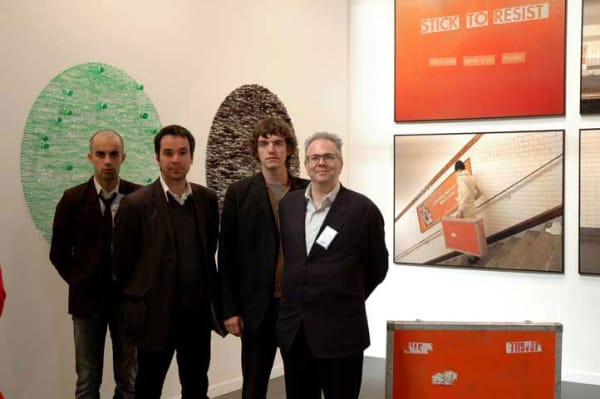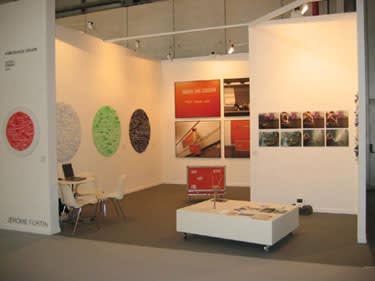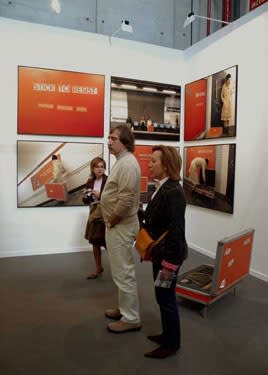February 10-14, 2004
ARCO'05, Madrid
Artists presented: Michel de Broin + Jérôme Fortin
Michel de Broin
Although de Broin is in his early thirties, his artistic career is already an impressive and highly coherent one. His many residencies in Europe and his participation in important exhibitions — most notably in France (Made in France at la Vitrine, Paris and Superficielle at FRAC Alsace, 2004; Germany (Épater la galerie, Villa Merkel and Bahnwaterhaus, Essenglin, 2002), Switzerland (Kunsthaus Basselland, 2001) and the United States (Au courant, Center for Curatorial Studies, Annandale-on-Hudson, New York, 2001) — have earned him recognition abroad. He is the recipient of the Krasner-Pollock Foundation Prize (1999) and Prix Pierre-Ayot (2002). A major article on his work to date was published this year in Parachute no. 115 under the theme of "resistance". Through his work and his determination, de Broin has shown true talent for borrowing concepts from fields as diverse as philosophy, hydraulic engineering, and art history, and really putting them to work in perceptual arrangements. De Broin takes it upon himself to disrupt what counts as authority, establishing relationships between material forms and social codes. His strategy consists in giving meaning to what lacks it by taking it from authoritative sources. It is his way of creating original connections, where the meaning disrupted by the combinatory junctions is put back into play in a special way each time.
At ARCO'05, Michel de Broin intends to present, work from the series, "Réparations", and "Stick to Resist". "Réparations" is an action that was staged in the suburban of Paris and then in the center. In Réparations, used water bottles are filled with compressed air and liquid, then projected like rockets a 100 feet in the air. During a stroll, bottles haphazardly discarded in the street find themselves, one after another, blown into the Paris sky.
The robot "Stick to Resist" consists of a high capacity (300-kilo) electromagnet that can be installed on metal surfaces in public spaces, like the Eifel Tower. The robot can be activated or deactivated with an electronic signature provided by the user. Otherwise it will refuse to be removed from its solid attachment. When activated, a countdown shows the battery-life, suggestive of a time bomb; far from being the case, when the countdown ends, the electromagnet falls to the ground. Stick to Resist is a functional robot, working with a battery, a memory, and a relative level of autonomy. The electromagnet is an electrical resistor, by resisting, the device makes its presence felt and stands solidly by its own.
Jérôme Fortin
With his sustained attention in capturing the formal value of the little things that crisscross our everyday lives — and his tireless patience in handling them —, Jérôme Fortin brings stunning visual poems to light. Fortin summons us to a meditation on disposability and the culture of mass consumption permeating our imaginations, to a meditation on the attendant wastage of time. The insignificant in our material civilization takes on unforeseen value here; and it accompanies a sense of the urgency of reactualizing body and gesture, outside the purview of automated routine and instant performance. With this artist, looking on the object becomes a form of meditation. He renews the field of the handmade in the visual arts; recycled materials and the form taken on by the work exchange their respective natures and become indistinguishable: from little things left by the wayside, an age-old memory is kindled regarding what binds self to world, eye to hand.
Jérôme Fortin, recipient of the 2004 prix Pierre-Ayot, awarded by the City of Montreal, in collaboration with L'Association des galeries d'art contemporain (AGAC), has had work shown in several group exhibitions in Quebec and abroad, such as the Biennale de Montréal in 1998, Galerie UQAM in 2000, and the Officina America in Bologna in 2002. For a residency in New York, he produced work that was to be presented as part of the exhibition Growth and Risk – Québec New York 2001, but that was tragically interrupted by the events of September 11. The New York Times published on 11 September 2001 a major article on his process of creation: Plumbing a City's Curiosities in the Name of Art by Randy Kennedy. His first solo show within the institutional framework of a museum, Ici et là, was presented in 2002 at the Musée d'art de Joliette and is currently touring in Canada. It will be presented in Tokyo in 2006. His work can be found in the collections of the Musée national des beaux-arts du Québec, the Musée d'art contemporain de Montréal, the Musée d'art de Joliette and several private collections. The Musée d'art contemporain de Montréal just announced his inclusion in a major show of young Canadian artists in the Summer 2005.
Seascape/Madrid, to be presented at ARCO'O5, is a new installation from an ongoing series inspired by bottles washed up along the shorelines of the St. Lawrence River. Fortin travels to various cities and transforms found objects collected in situ from which ever city he finds himself in. Seascape/Madrid will comprise large mural circles formed from coloured plastic bottles that have been cut and stapled to the wall - forming an abstract composition with unusual materials.
ARTICLES
Lamarche, Bernard. Le Devoir, Foire d'art contemporain à Madrid - Chance à demi ratée pour le Canada à l'ARCO, February 11, 2005
Bellet, Harry. Le Monde, Marché de l'art: Le Mexique invité d'honneur de l'Arco de Madrid, February 13, 2005
Radio Canada International, Spotlight video interview, February Edition of the Canadian World Arts Calendar, February 1, 2005.
Marin Medina, José. El cultural, Zona de ensanche. Arte emergente Nuevos territorios en ARCO
Spiegel, Olga. La Vanguardia.es, Arte en una caja negra, February 13, 2005
Jérôme Fortin makes front page on ABC de Arco, numero 3, February 2, 2005





